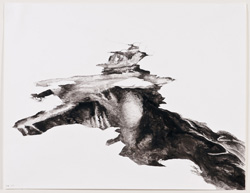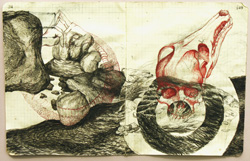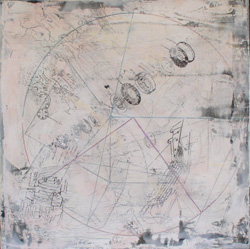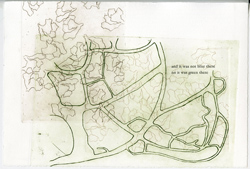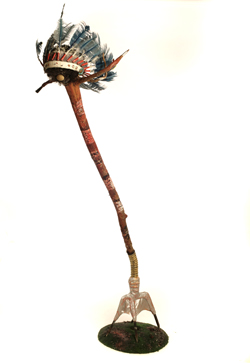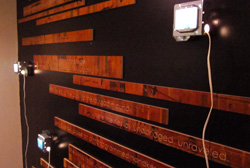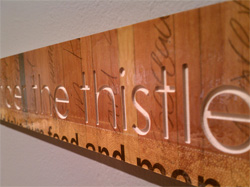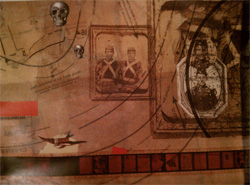Satellite Exhibition
Pushing Boundaries:
Art as Metaphor in Love and War
Summer — Fall, 2011
Pushing Boundaries: Art as Metaphor in Love and War, 1708 Gallery’s latest satellite exhibition at Richmond’s historic Linden Row Inn, features artists from across Virginia. Curated by local artist and 1708 Gallery Board Member Amie Oliver, Pushing Boundaries will be on view through the month of October. The proceeds from all art sales benefit the artist and the exhibition programs of 1708 Gallery, with the exception of Roberto Ventura and Joshua Poteat’s “For Lucy and Yardsale.” The proceeds from the sale of this installation will be donated to the Daily Planet, a nonprofit organization that provides services to those at risk of, or experiencing, homelessness.
Curatorial Statement
Pushing Boundaries: Art as Metaphor in Love and War consists of painting, prints, sculpture, drawing and installation work by artists who contribute to the rich cultural landscape in Virginia. This exhibition coincides with the 150th anniversary of the American Civil War and presents artists who push the boundaries of their medium and as well as reveal personal interpretations of themes embedded in our history, landscape and literature.
Boundaries are often referred to as something that indicates the farthest limit, as of an area; border in the context of team sports as well as national defense. The department of defense determines a boundary to be a line that delineates surface areas for the purpose of facilitating coordination and deconfliction of operations between adjacent units, formations, or areas on land or in airspace.
Other references to this term explore the importance of setting personal boundaries. It is a term which refers to the political, personal and public space and one which has resulted in physical and symbolic lines of demarcation that have inspired some of the greatest propaganda, cartography and historical dramas the world has ever known.
Line, and its implied role in the sand or on the map, is an elemental component for each of the artists presented here. Genesis Chapman's (Bent Mountain) ink drawings of Bottom Creek are a primary example of this duality with each strata of earth implying a generation of farmers, fathers, sons, mothers and daughters. Chapman's sense of "loss" and his investigation of its "sense of place" are evident with each mark of his pen or brush.
Ed Dolinger (Roanoke) created a series of mixed media paintings which imply maps, parables and theorems on fields of color. The history of the surface sets the tone of each panel and our reading of it. Kris Iden (Charlottesville) has created the series of color intaglio printed titled "…the world is round" inspired by the Gertrude Stein children's book of the same name. This poetic sequence of 15 prints emphasizes the circularity of time and identity and the ability for each to fold it back upon itself. Iden explains "This intensely personal work is a reflection of the feelings of being caught between two cultures, two dearly held landscapes, and the process of constructing an intimate hybrid-geography." Greg Kelley's (Richmond) mixed media sculptures are totem like "combines" which reflect a hybrid iconography of our history and culture.
Joshua Poteat and Roberto Ventura (Richmond) created the installation For Lucy and Yardsale. They present fragments of Poteat's poetry as an unconventional memorial consisting of wooden strips of text, collage, light boxes and other media. This work is an ode to the relationships that form and are lost within the invisible boundaries in which Richmond's homeless residents reside.
Amie Oliver
1708 Gallery Satellite Exhibitions Liason and Curator
Exhibiting Artists
Genesis Chapman, Bottom Creek, VA (ink drawings)
My art aims to examine and investigate Bent Mountain, Virginia, which is the place I grew up, and a place I deeply love. As a small rural community in the Blue Ridge Mountains, it is known for its natural beauty. In my art, I wish to show the respect and love I have for nature.
I choose to represent the "genus loci" of Bent Mountain in a tangible form. To me, this is embodied in the most basic elements of the land, and the processes that shape the landscape; the actions of weather, air, water, stones and rocks.
Stripping out most of the landscape allows me to concentrate on the movement of these forces of nature, and to highlight the energy, changes and flow of the water and creeks that shape the mountain in a way that reflects my emotions, observations, ideas and experiences. I record the changing dynamics of the mountain in a historical, geological, and personal scale of time.
The use of black and white India ink is important because of its directness and simplicity. I focus my brushwork on the patterns across the surface of the water. Metaphorically and literally, water carries the ink across the paper and evaporates to leave a sedimentary mark. The improvisational nature of the spontaneous mark empowers me as an artist as who acutely observes nature. While part of me that wants to describe the creek with scientific precision, I challenge myself to open up and pay attention to the spontaneity of my process. Instead of literally depicting the Nature I describe its action and energy with obsessive marks that range from large spontaneous gestures to intricate detailed meditations.
I choose to depict the rest of the landscape as a white featureless void, rather than yet another romanticized version of the mountains. The trees, plants, animals, soil, rocks, light, sun, and reflections are present in their glaring and painful absence. This hollowness is further emphasized in the spontaneous shapes and voids the creek creates. While emphasizing what may disappear or is lost, this depiction also questions the transitional aspect of what we really see or experience in Nature.
Ed Dolinger, Roanoke, VA (mixed media paintings)
The longer I am engaged in the act of “making art” the more absurd and audacious it seems. Yet it doesn’t seem to dampen that invisible fuel source that moves my butt into the studio damn near every day. I suppose it reflects that ubiquitous “Art imitating life” quote. Reflecting and including all that is so wonderful and repugnant about the human experience. I seek to purge sermonizing from content and to reveal the contradictions and competing opposites that are a constant in life. Curiously and happily not resolving anything. Gobs of information, but no apparent message.
A short note on the techniques that I employ in my paintings: all are acrylic and mixed media on various board surfaces (masonite, luan plywood, medium density fiberboard) that are applied over multi-layered primed surfaces. Each layer of paint (or primer) is sanded between coats with 300-600 grit wet/dry sandpaper. All acrylic paint is mixed with water-based polyurethane floor paint, resulting in a very hard but sandable and polishable surface. Xerox transfers and water-slide decals are introduced on most layers, as well as some drawing techniques. The end product (between 24 and 32 inches square) is somewhere around 20-50 layers that establish a rather industrial appearing surface that belies the very physical process.
Kris Iden, Charlottesville, VA (color intaglio prints)
While living in Germany from 2006–2009, I produced two multiple-series bodies of work, "Movement in Plants", and "Flora", and worked in collaboration with the printers at Grafikwerkstatt Dresden. I developed numerous etching plates that have been used repeatedly throughout my work of the last four years. The images in these plates include fragments of my work from the last eighteen years, along with plants in my former garden in Richmond, the map of Dresden’s botanic garden, and contour line maps of the state of Virginia and the state of Saxony in Germany.
Just before my return to Virginia in 2009, I began a new body of work titled "It was green there." The title comes from a book for children by Gertrude Stein titled, The World is Round, which tells the story of nine-year-old Rose who goes on a journey in search of herself and struggles to establish a stable identity in a round world of variability. The complex and labyrinthine qualities of the tale mirror her efforts, resulting eventually in a story, but in the process, move it in circularity and fold it back upon itself.
Included in this new body of work is a series of prints titled, "…the world is round". The text in these prints, excerpted from Stein’s book, was printed with collaborative assistance from the letterpress printer at Grafikwerkstatt, and completed before I left Dresden. The emblematic intaglio images, from my archive of plates, were printed after I returned to Virginia.
This intensely personal work is a reflection of the feelings of being caught between two cultures, two dearly held landscapes, and the process of constructing an intimate hybrid-geography. However, it is intended to be non-biographical and to simply provide a poetic catalyst, from which viewers may project and dwell in their own experiences of place, identity and image.
"…the world was round and you could go on it around and around."
-Gertrude Stein
Greg Kelley, Richmond, VA (mixed media sculptures)
I am seeking to express the piece that describes perfectly the relationship between the apparently “artificial man made world and the “natural preexisting world. I take inspiration and challenge from my lineage of object and image makers reaching into the archives of our energetic history. At some point the time of a distant shaman making a rattle with which to guide a lost soul and my activity as contemporary American artist coincide in a unique definitive, purpose filled way. I seek to express that meeting point.
Joshua Poteat and Roberto Ventura, Richmond, VA (mixed media and installation)
Location factors largely in our poems (Poteat) and designs (Ventura). Site embodies a complex system of visible and invisible factors, influences and echoes.
In Illustrating the Construction of Railroads, Poteat considers the undefined areas that link what we recognize as places.
Partially we dismiss this edge because it exists unnamed. Without a label, places and people recede from consciousness.
However, the spaces between places teem with life. Despite their lack of definition these stories and landscapes shape our community.
Erasure poetry is a form of found poetry created by erasing words from an existing text in prose or verse and framing the result on the page as a poem. The results can be allowed to stand in situ or they can be arranged into lines and/or stanzas. This erasure originated with an exhibit at the Flippo Gallery at Randolph-Macon College.
